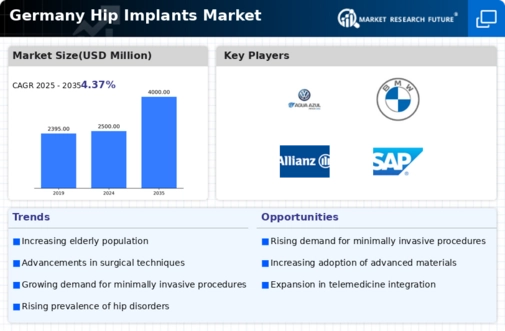Increased Healthcare Expenditure
Germany's healthcare system is characterized by high levels of expenditure, which significantly impacts the hip implants market. The country allocates around 11.7% of its GDP to healthcare, reflecting a commitment to providing advanced medical treatments. This financial support facilitates the adoption of innovative technologies in hip implant procedures, including minimally invasive techniques and improved implant designs. As hospitals and clinics invest in state-of-the-art equipment and training, the quality of care for hip replacement surgeries improves, potentially leading to higher patient satisfaction and better outcomes. Consequently, the hip implants market is likely to benefit from this increased investment in healthcare infrastructure, as more patients seek surgical solutions for hip-related ailments.
Growing Awareness of Joint Health
There is a notable increase in public awareness regarding joint health in Germany, which serves as a catalyst for the hip implants market. Educational campaigns and health initiatives are promoting the importance of maintaining joint function and addressing issues early. This heightened awareness encourages individuals experiencing hip pain to seek medical advice sooner, leading to earlier diagnoses and treatment options, including hip implants. Additionally, the rise of fitness and wellness trends may contribute to a proactive approach to joint health, further driving demand for surgical interventions when conservative treatments fail. As a result, the hip implants market is poised for growth, fueled by a more informed population.
Rising Incidence of Hip Disorders
The increasing prevalence of hip disorders in Germany is a primary driver for the hip implants market. Conditions such as osteoarthritis and rheumatoid arthritis are becoming more common, particularly among the aging population. According to recent health statistics, approximately 20% of adults over 65 in Germany experience significant hip pain, necessitating surgical intervention. This trend is likely to escalate as the population ages, leading to a higher demand for hip implants. Furthermore, advancements in surgical techniques and implant materials are enhancing patient outcomes, which may encourage more individuals to opt for hip replacement surgeries. As a result, the hip implants market is expected to witness substantial growth, driven by the need to address these prevalent health issues.
Supportive Regulatory Environment
The regulatory environment in Germany plays a crucial role in shaping the hip implants market. The country has established stringent guidelines that ensure the safety and efficacy of medical devices, including hip implants. This regulatory framework fosters innovation by providing a clear pathway for the approval of new technologies and materials. Additionally, the German Institute for Standardization (DIN) and the Federal Institute for Drugs and Medical Devices (BfArM) actively support research and development in the field. As a result, manufacturers are encouraged to invest in the development of advanced hip implant solutions, which may lead to an expansion of the market. The supportive regulatory landscape thus appears to be a significant driver of growth in the hip implants market.
Technological Innovations in Implant Design
The hip implants market is significantly influenced by ongoing technological innovations in implant design and materials. Recent advancements have led to the development of more durable and biocompatible materials, which enhance the longevity and performance of hip implants. For instance, the introduction of ceramic-on-ceramic bearings has shown promising results in reducing wear and tear, potentially extending the lifespan of implants. Furthermore, 3D printing technology is revolutionizing the customization of implants, allowing for tailored solutions that meet individual patient needs. These innovations not only improve surgical outcomes but also increase patient confidence in undergoing hip replacement procedures, thereby driving market growth.

















Leave a Comment